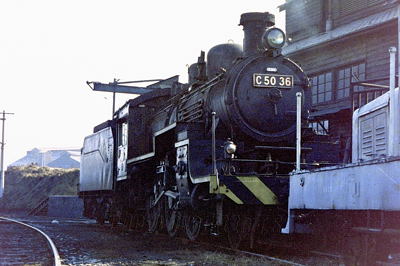
C50 No.36
Shiojiri depot, Jan 1969.
Japanese
|
1928 - 1972 A middle-sized Tender-Engine for mid-range light trains. |

C50 No.36 Shiojiri depot, Jan 1969. |
|
C50 was an improved engine from class 8620, and a total of 154 (*) were produced from 1928.
But, C50's were designed to have a more modern appearance, but the timing was already too late.
Thus, the real purpose of a "light and high-speed engine" had a rather brief history.
Therefore, succeeding engine designs followed.
(* JGR - 154, Karafuto R.- 4, Total - 158) During WW2, C50 numbers 1 thru 5 were moved from Kagoshima during June 1941 to Chinese held Formosa (present day Taiwan). They were used continuously on the Taiwan Railway after WW2, as Taiwan Railway Class CT-230, (No.CT230 - CT235). CT-230s worked until the 1960s in Taiwan. Manufactured during 1930, four C50s were ordered from Karafuto Railway. (currently South-Sakhalin in Russian territory.) At that time, Karafuto was Japanese territory, and railway oversight organization was an independent organ from the Japanese government railway. Karafuto's C50s were named class 8650 No. 8650 - 8653, and later they were renamed to the Karafuto railway's class C50 No.1-4. But when the Karafuto railway was integrated with the Japanese government railway during 1943, they were again renumbered with the ensuing JGR C50's No. 155-158. These four engines were lost by the wars end. After the war, 144 C50s survived, with the exception of ten which were moved to Taiwan (No.1-5) and were war damaged (No.39,70,84,87 and 94). They were restricted to yard work, a few saw freight train service only on the Mito and Ryomo lines ... etc. C50 culling began in 1957, and were decreased to 15 during 1971.
3 in the Kamisuwa depot (No.36, 42 and 119), 5 in the Yanai depot (No.57, 67, 113, 125 and 132), 1 in the Kii-Tanabe depot (No.88), 2 in the Toyohashi depot (No.95 and 96), 2 in the Inazawa depot (No.101 and 132), 2 in the Kameyama depot (No.109 and 154). Later, Kamisuwa's No.36 and 42 were transferred to the Kagoshima depot. And finally, C50's history was closed during late 1972, as Kagoshima depot's two (No.36 and 42) and Kameyama depot's two (No.109 and 154). They led a rather unspectacular life, yet, their role in railroading played a very large part. |
| Primary ran line in last 10 years |
Ryomo line,
Hiroshima,
Ryuge,
Kagoshima,
Yukuhashi and
Oyama depot etc ...
| Last line/depot and year |
Kagoshima, Kameyama depot 1972
| Restored engine (2017) |
none
| Preserved engine (2017) |
5 (No.75, 96, 103, 123, 154)
| |
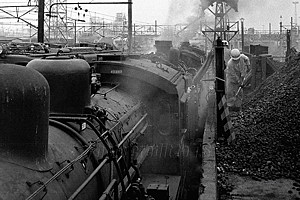
|

| ||||||||||||
|
Oyama depot's C50s, during Mar 1970.
|
C50 No.142 seen here at Fukuyama station.
Mar 1967.
| 
| 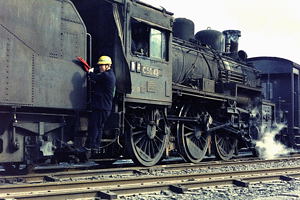
C50 is shown here with its colorful markings | in yard work at Itozaki yard... the markings clearly seen, add a margin of safety for all involved. C50 No.66 Dec 1968.
C50_42 shunting operation at Shiojiri yard 1970. |
| 
| 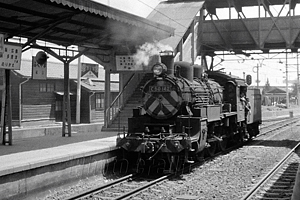
C50_110 at Oyama depot. Mar 1969.
| C50_142 at Fukuyama station.
| 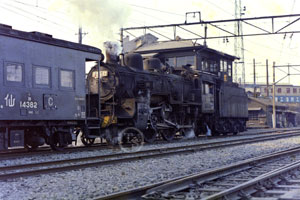
| 
C50_42 at Shiojiri yard.
| Left C50_42 and C50_119 right, at Shiojiri depot. They are decorated with a New Year flags. Jan.1970 |
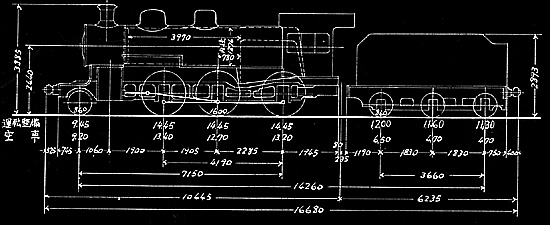
| Configuration | 2-6-0 | Dimensions Length (mm) | 16880(16680) |
| Engine Weight (Operating tons) | 53.0(52.8) | Driver size (mm diameter) | 1600 |
| Boiler pressure (Kg/cm2) | 14.0 | Max Tractive effort (tons) | 11.1(10.9) |
| Driver Max Power (PS) | 610 | Max Speed (km/h) | 90 |
| Manufactured years | 1928-1932 | Total production | 158 |
| Number of moved out to other countries in WW2 with gauge remodeling. | 9 | Gauge | 3ft 6in (1067mm) |
* Parenthetic ; After No.68 |
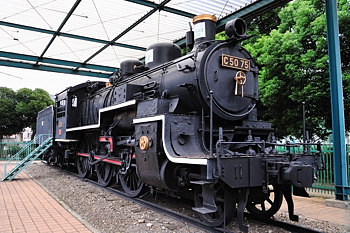
|
|
One of the preserved C50, C50_75 She was retired on 8th Mar 1971 at the Kameyama depot. North Shikaha Park in Adachi Tokyo, Sept 2008. |
Introduction |
Go to Top |